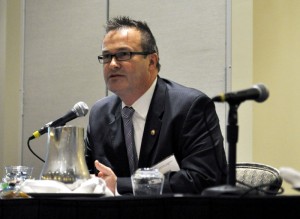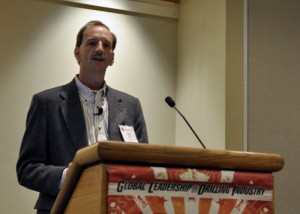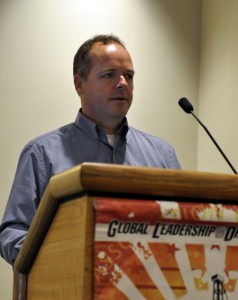Automation answers call for well efficiency, safety
By Joanne Liou, editorial coordinator

Automation is not a new idea and is widely used in many industries. Yet, the idea of translating best practices, engineering principles and human experience into algorithms that would make decisions in place of a driller is met with the most basic barrier in attitudes toward change. Andrew Bruce, VP controls at National Oilwell Varco (NOV), joined Jim Rogers, automation advisor at Apache Corp, for the technology session at the 2011 IADC Annual General Meeting last week in Austin, Texas. These automation experts discussed the drilling industry’s need for step changes instead of incremental changes in the drilling process and the value of automation.
Although the industry has come a long way in drilling technologies and safety performance, it falls behind other industries, such as automotive, aviation and chemical, when it comes to automation. “We know how to drill. We’ve been drilling for a long time,” Mr Rogers said. “The process is not broken, but that doesn’t mean we can’t do a better job of it. It doesn’t mean we can’t identify improvement.”
For one, automation could be used to move the driller out of danger’s way. In the chemical industry, for example, operators work in a control room away from the processes. In one of Mr Rogers’ previous projects, a central control room was built a half-mile from the process with blast walls and without windows. In contrast, the driller is still working on the rig. “The driller is the sensor. We’re relying on him to tell us what’s going on in the process,” Mr Rogers said. Without properly setting up the rig with the necessary sensors to enable automation, we depend on the driller to provide feedback on how the drilling process is going, whether through vibrations, noises or smells.

There is strong incentive to remove the driller from the risks on the rig. Mr Rogers shared statistics of workplace fatalities across all industries provided by the US Department of Labor indicating that three of the top four fatality categories are highway incidents, falls and struck by object, all applicable to drilling. Further dissection of the data showed those three categories remain among the top causes for fatalities specifically among US oil and gas companies, including contractors. Clearly, there is an incentive for more automation when it comes to safety, Mr Rogers said.
Although training and regulations support a safer workplace, they are also attempts to mitigate risk, Mr Rogers explained. “The ounce of prevention is to design risk out, find ways to remove the hazard from drilling,” he said. “Can we take the doghouse and set it on the ground 50 meters away like they do with the central control room in refining? Can we get people off the rig floor, instrument the rig and move them out of the hazard? That’s an ounce of prevention that will go a long way.”
The business climate is ripe for automation as well, considering an increasing global energy demand and the growing role of unconventional gas in the energy mix, which requires significant numbers of wells to be drilled. “It takes an order of magnitude more wells than what we’re traditionally used to (to exploit hydrocarbon resources),” Mr Rogers said. “And your production cycle on that well might be 18 months, might be six months, might be less.”
Refuting what some might consider barriers to automation – lack of understanding and capability, lack of standards, lack of technology and lack of incentive – Mr Rogers explains the actual barriers are in people’s natural resistance to change and how the industry’s revenue stream is formulated around how things are done today. “We’re afraid of rocking the boat,” he said.
Discussing automation from a service company perspective, Mr Bruce gave his support to Mr Rogers’ position on automation. “As Jim said, a lot of the problems we have today are what we have; the sensors on the rig and the instrumentation and the actual equipment itself have been designed to be manually run,” Mr Bruce said. “What we need to be thinking about is how do you look at the process differently.”

For NOV, the industry’s increasing focus on shale gas and the economics that follow drives the path for automation, Mr Bruce stated. “Technology innovations are going to drive efficiencies to drive the costs down. There are a lot of challenges; trying to bring it all together is not as easy as it seems,” he added. In September 2010, Mr Bruce began the task of building a new drilling control system, one that didn’t represent incremental change of something that already existed. He compared the challenge to going from the Telex machine to a fax machine.
To achieve that kind of step change, the industry needs to start questioning the business model, Mr Bruce said. “We need to be prepared to question the process and how we’re going to work together. What’s the financial market? What’s the financial incentive?”
Further, the challenge in changing the way automation is approached poses another hurdle of thinking differently. “The one thing that came out of my research more loudly than anything else is the (drilling) process. How do we improve the process? How do we make the process more streamlined? How do we make it safer?”
In the long road to automation, there is light at the end of the tunnel. “The good news is we can do it all. Everything we need to do, exists – all the way from the bit to the wired pipe to the top drive, to the driller’s chair all the way to a remote operating center and back again,” Mr Bruce stated. “We as a company can do it, let alone, we as an industry. So that’s what we are doing; we are tying it all together.”




